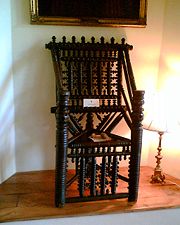
Turned chair
Encyclopedia

Armchair
An armchair is a chair with arm rests.Armchair may also refer to:*Armchair nanotube, a carbon nanotube with chiral symmetry*Armchair, a sitting sex position*Armchair , a bus operator in London...
, made by turners with the use of a lathe, rather than by joiners or carpenters. They are of European origin, travelling to the Americas with European colonists, then developing somewhat independently there.
The earliest turned chairs are of uncertain date, but they became common in the 17th century. Before this date there are rare examples that claim to date back to before 1300 , but most of these early examples are from manuscripts.
The characteristics of a turned chair are that the frame members are turned cylindrical on a lathe. The main uprights are usually heavier and plainly turned, the lighter spindles infilling between them are more decoratively turned, often with repeated bobbin turning, so as to appear as a series of balls, beads or bails. The complexity of this turning varies widely, and is used as a guide to identifying the region of origin. Some chairs have so many spindles that their backs and sides form an almost solid latticework, akin to the Arabic lattice windows or "Meshrebeeyeh". Eighteenth century turned chairs became far simpler. Eventually their techniques influenced the celebratedly simple and elegant style of the Shaker chair, still largely made by turning.
Three-legged chairs are common, particularly for older examples. The evolution of the chair is from the simple backless stool
Stool (chair)
A stool is one of the earliest forms of seat furniture. It consists of a single seat, without back or arms rests, on a base of either three or four legs. A stool is distinguished from chairs by their lack of arms and a back...
, commonly three-legged for stability. As there is no wide back, there is no reason to have more than one rear leg. These gave rise to the backstool, a backless stool with one leg extended upwards and later widened by a flat pad. As this pad developed further and wider it began to be supported by diagonal spindles for strength. These gave rise to the arms of the three-legged turned chair (illustrated). In time the turned chair gained a fourth leg and a square plan, becoming closer to the modern chair. Its evolution is through these three-legged stools though, not from the square chest and the throne-like box chairs.
Seats are commonly solid, but these are often replacements and their original material is uncertain. For later examples, especially from America, a rush seat is common.
Most turned chairs are of ash
Ash tree
Fraxinus is a genus flowering plants in the olive and lilac family, Oleaceae. It contains 45-65 species of usually medium to large trees, mostly deciduous though a few subtropical species are evergreen. The tree's common English name, ash, goes back to the Old English æsc, while the generic name...
, but they are also found in fruitwoods and American specimens may use hickory
Hickory
Trees in the genus Carya are commonly known as hickory, derived from the Powhatan language of Virginia. The genus includes 17–19 species of deciduous trees with pinnately compound leaves and big nuts...
, cherry
Cherry
The cherry is the fruit of many plants of the genus Prunus, and is a fleshy stone fruit. The cherry fruits of commerce are usually obtained from a limited number of species, including especially cultivars of the wild cherry, Prunus avium....
and maple
Maple
Acer is a genus of trees or shrubs commonly known as maple.Maples are variously classified in a family of their own, the Aceraceae, or together with the Hippocastanaceae included in the family Sapindaceae. Modern classifications, including the Angiosperm Phylogeny Group system, favour inclusion in...
. Use of oak
Oak
An oak is a tree or shrub in the genus Quercus , of which about 600 species exist. "Oak" may also appear in the names of species in related genera, notably Lithocarpus...
itself is relatively rare, but their age and relatively simple style means that they are normally counted as part of the "Age of Oak" furniture.

